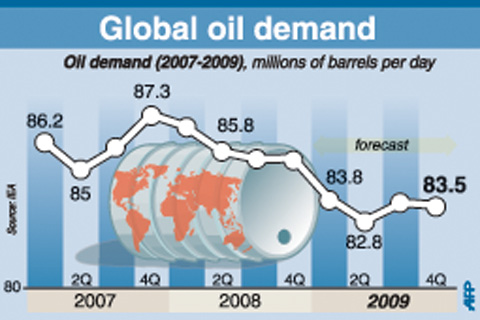Oil prices rose sharply on Thursday despite more hints that energy use is way down, with traders focusing instead on a rising stock market and surprising news from retailers that suggests Americans are spending money.
If registers at the mall are ringing, that likely means people are driving.
Benchmark crude for May delivery rose nearly 6 percent, or US$2.86, to settle at US$52.24 a barrel on the New York Mercantile Exchange (NYMEX).

Trading was very light on a shortened trading week. The NYMEX was closed for Good Friday.
In London, Brent prices jumped US$2.47 to settle at US$54.06 a barrel on the ICE Futures exchange.
“A lot of little things are giving investors hope that maybe the economy has seen the worst,” said Andrew Lebow, senior vice president and broker at MF Global.
In the past week, home decor chain Bed Bath & Beyond Inc and restaurant Ruby Tuesday Inc have reported better-than-expected first-quarter results. Teen retailer Hot Topic Inc said sales at stores open at least a year rose more than analysts’ forecasts.
On Thursday, Wal-Mart Stores Inc said sales at stores open at least a year, excluding fuel, rose 1.4 percent, short of the 3.2 percent rise analysts were predicting. However, the world’s largest retailer said a later Easter was to blame and that this month’s sales were likely to be boosted by the holiday.
The US government on Thursday said new jobless claims fell more than expected. The Labor Department’s tally of initial jobless claims fell to a seasonally adjusted 654,000, down from a revised 674,000 the previous week. Analysts expected claims to drop only to 660,000.
“People are buying oil when they see signs of economic hope,” said Phil Flynn, analyst at Alaron Trading Corp.
Flynn said he would know that global demand has returned — and higher crude prices justified — when he sees both a significant drop in petroleum supplies and a decision by refineries to crank up their operations.
“Right now, we’re not seeing that,” Flynn said.
The US government reported on Thursday that natural gas storage levels in the US rose more than expected last week. Natural gas is a key energy source for many power plants and factories. Rising storage levels suggest that people are using less energy, and companies are making fewer products.
Workers in energy-intense industries like metals or manufacturing have been hit especially hard in recent rounds of job cuts. That is reflected in the growing stocks of oil and natural gas in US storage facilities. It is potential energy that is not being used, one side effect of a very bad recession.
The US Energy Department’s Energy Information Administration said in its weekly report that natural gas inventories held in underground storage in the lower 48 states rose by 20 billion cubic feet (566.3 million cubic meters) to about 1.67 trillion cubic feet for the week ended last Friday.
Analysts had expected a boost of between 11 billion to 16 billion cubic feet, according to a survey by Platts, the energy information arm of McGraw-Hill Cos.
On Wednesday, the US government reported crude supplies increased by 1.7 million barrels and gasoline inventories rose by 600,000 barrels,
OPEC countries continue to trim crude production in hopes of siphoning off a global surplus. Tanker tracker Oil Movements reported on Thursday that shipments from the Organization of Petroleum Exporting Countries are expected to drop another 280,000 barrels for the four-week period to April 25.
Meanwhile, with US gas supplies well above average for this time of year, refiners have cut back on gasoline production, which has in turn helped boost prices. The Energy Information Administration said 767,400 barrels of refining capacity will be offline this month, up 14.5 percent from the historical average of 670,000 barrels of offline capacity.
That could mean tighter supply and higher prices in some regions, particularly on the East Coast in the next couple of weeks.
This is the season when refineries shut down for repairs and switch over to summer blends. That, along with more people hitting the road, usually means higher gasoline prices.
In other NYMEX trading, gasoline for May delivery rose US$0.0414 to settle at US$1.4810 a gallon (US$0.3912 a liter) and heating oil gained just more than US$0.03 to settle at US$1.4288 a gallon.

WAITING GAME: The US has so far only offered a ‘best rate tariff,’ which officials assume is about 15 percent, the same as Japan, a person familiar with the matter said Taiwan and the US have completed “technical consultations” regarding tariffs and a finalized rate is expected to be released soon, Executive Yuan spokeswoman Michelle Lee (李慧芝) told a news conference yesterday, as a 90-day pause on US President Donald Trump’s “reciprocal” tariffs is set to expire today. The two countries have reached a “certain degree of consensus” on issues such as tariffs, nontariff trade barriers, trade facilitation, supply chain resilience and economic security, Lee said. They also discussed opportunities for cooperation, investment and procurement, she said. A joint statement is still being negotiated and would be released once the US government has made

NEW GEAR: On top of the new Tien Kung IV air defense missiles, the military is expected to place orders for a new combat vehicle next year for delivery in 2028 Mass production of Tien Kung IV (Sky Bow IV) missiles is expected to start next year, with plans to order 122 pods, the Ministry of National Defense’s (MND) latest list of regulated military material showed. The document said that the armed forces would obtain 46 pods of the air defense missiles next year and 76 pods the year after that. The Tien Kung IV is designed to intercept cruise missiles and ballistic missiles to an altitude of 70km, compared with the 60km maximum altitude achieved by the Missile Segment Enhancement variant of PAC-3 systems. A defense source said yesterday that the number of

Taiwanese exports to the US are to be subject to a 20 percent tariff starting on Thursday next week, according to an executive order signed by US President Donald Trump yesterday. The 20 percent levy was the same as the tariffs imposed on Vietnam, Sri Lanka and Bangladesh by Trump. It was higher than the tariffs imposed on Japan, South Korea and the EU (15 percent), as well as those on the Philippines (19 percent). A Taiwan official with knowledge of the matter said it is a "phased" tariff rate, and negotiations would continue. "Once negotiations conclude, Taiwan will obtain a better

FLOOD RECOVERY: “Post-Typhoon Danas reconstruction special act” is expected to be approved on Thursday, the premier said, adding the flood control in affected areas would be prioritized About 200cm of rainfall fell in parts of southern Taiwan from Monday last week to 9am yesterday, the Central Weather Administration (CWA) said. Kaohsiung’s Taoyuan District (桃源) saw total rainfall of 2,205mm, while Pingtung County’s Sandimen Township (三地門) had 2,060.5mm and Tainan’s Nanhua District (南化) 1,833mm, according to CWA data. Meanwhile, Alishan (阿里山) in Chiayi County saw 1,688mm of accumulated rain and Yunlin County’s Caoling (草嶺) had 1,025mm. The Pingtung County Government said that 831 local residents have been pre-emptively evacuated from mountainous areas. A total of 576 are staying with relatives in low-lying areas, while the other 255 are in shelters. CWA forecaster